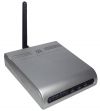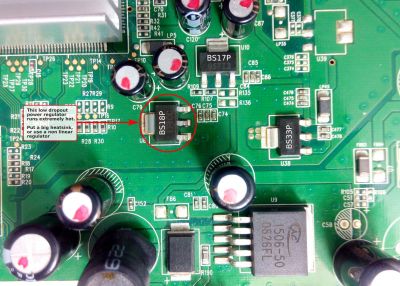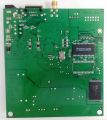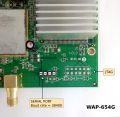Pheenet WAP-654G
Pheenet WAP-654G
(Est.) release date: 2007
(Est.) initial retail price (in USD): $50
Country of manuf.: Taiwan
Type: access point, repeater
Power: 12 VDC, 1 A
Connector type: barrel
CPU1: Realtek RTL8186 (180 MHz)
FLA1: 2 MiB2,097,152 B <br />16,384 Kib <br />2,048 KiB <br />16 Mib <br />0.00195 GiB <br /> (Macronix MX29LV160CBTC-70G)
RAM1: 16 MiB16,777,216 B <br />131,072 Kib <br />16,384 KiB <br />128 Mib <br />0.0156 GiB <br /> (ISSI IS42S16800A-7TL)
Expansion IFs: none specified
JTAG: yes, 12-pad header, J1
Serial: yes, 4-pin header, JPU1
WI1 chip1: Realtek RTL8186
WI1 802dot11 protocols: bg
WI1 antenna connector: RP-SMA
ETH chip1: Realtek RTL8201CP
LAN speed: 100M
LAN ports: 1
bg
Stock bootloader: btcode
Stock FW OS: Linux 2.4.18 MIPS-01.00
TPFirmware supported: Wive-NG (sfstudio) • (Blog | List)
Flags: high power
Default SSID: PheeNet
Default IP address: 192.168.1.254
the IP 192.168.1.254 is used by 158 additional devices
of which 0 are Pheenet devices
Default login user: admin
Default login password: admin
admin:admin credentials used by 1331 additional devices
of which 0 are Pheenet devices
802dot11 OUI: 00:1A:50
For a list of all currently documented Realtek chipsets with specifications, see Realtek.
802.11g 54Mbps High Power AP / Bridge
See also Pheenet WAP-654GP (int. splitter PoE)
- 2.2dBi detachable antenna (RP-SMA conn.)
Base Platform: RTL8186 + RL2560 (MIPS R3000 ISA-1) Spec.
Very simple access point with WIFI high output power (200mW)
- that allows several wifi modes:
- AP, WDS, AP + WDS, Client bridged, Ad-hoc
- AP + Client bridged (aka Universal Repeater)
The original firmware doesn't have Telnet or other remote CLI interface.
- It only can be configured via web interface.
It is worth mentioning the web interface doesn't allow to reboot the router,
- however there is a hidden page that allows to execute custom commands:
httр://192.168.1.254/syscmd.asp
Some useful commands:
- Change the MAC adresss
flash set HW_WLAN0_WLAN_ADDR 001122334455flash set HW_NIC0_ADDR 001122334455 - Change the regulatory domain
flash set HW_WLAN0_REG_DOMAIN 6
Tested firmwares
Third party firmwares like Wive-NG were successfully tested in this unit.
| Version | Link | Notes |
|---|---|---|
| OEM 1.4c | WAP-654G(P)_v1.4c.zip | doesn't seem to flash via tftp |
| OEM 1.4b | WAP-654G(P), F v1.4b 070228.rar | |
| Wive-NG 0.3.18 | wive-ng-0.3.18.tar.7z | no web interface |
| Dlink 1.41-1 | DAP1160A1-OEM_MOD-1.41.zip | modded firmware from Dlink DAP1160A1 GPL |
Serial
| Expand • Boot log |
|---|
# cat /proc/version Linux version 2.4.18-MIPS-01.00 (root@lnx103) (gcc version 3.3.3) #5 Thu Aug 10 13:14:01 CST 2006 # cat /proc/cpuinfo system type : Philips Nino processor : 0 cpu model : R3000 V0.0 BogoMIPS : 178.99 wait instruction : no microsecond timers : no tlb_entries : 64 extra interrupt vector : no hardware watchpoint : no VCED exceptions : not available VCEI exceptions : not available ll emulations : 0 sc emulations : 0
Flash backup
- Connect the serial UART Adapter. Also connect the ethernet cable.
- Set a static IP on your computer, use 192.168.1.35 (or any compatible)
- Press the reset button, don't release it yet
- Plug the power cord, and wait 5 seconds
- Release the reset button
- On the serial console execute the command:
flr 80300000 0 200000 - On your computer execute:
tftp 192.168.1.6 -m binary -c get flash-backup.bin
You should see something like this at the serial console
<RealTek>flr 80300000 0 200000 Flash read from 00000000 to 80300000 with 00200000 bytes ? (Y)es , (N)o ? --> y Flash Read Successed! <RealTek> File Start: 80300000,length=00200000 **TFTP GET File flbackup.bin,Size 00200000 Byte *TFTP Client Download Success! File Size = 00200000 Bytes .Success! <RealTek>
Recovery
If you bricked the router by flashing a bad firmware follow these steps:
- Connect the ethernet cable from your computer to the device.
- Set a static IP on your computer, use 192.168.1.35 (or any compatible)
- Press the reset button, don't release it yet
- Plug the power cord, and wait 5 seconds
- Release the reset button
- On your computer execute:
tftp 192.168.1.6 -m binary -c put valid-firmware.bin
valid-firmware.bin is supposed to be a known firmware working ok on this device
Power regulators
- AnaChip AP1506-50 (U9 silkcreened): Main power regulator,12V input, 5V output
- BS33P (U38 silkcreened): Low dropout regulator, 5V input, 3.3V output
- BS17P (U10 silkcreened): Low dropout regulator (adjustable), 5V input, 3.1V output
- BS18P (U8 silkcreened): Low dropout regulator, 5V input, 1.8V output. It runs extremely hot, probably causing unstability problems. It's recommended to install the bigger heat sink as possible.
Images





